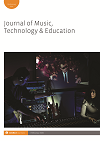- Home
- A-Z Publications
- Journal of Music, Technology & Education
- Previous Issues
- Volume 6, Issue 2, 2013
Journal of Music, Technology & Education - Volume 6, Issue 2, 2013
Volume 6, Issue 2, 2013
-
-
The effect of distance learning on acquisition of piano sight-reading skills
More LessAuthors: Pamela D. Pike and Kristin ShoemakerAbstractThe purpose of this research was to compare the acquisition of sight-reading skills between two groups of beginning piano students: the control group: students studying sight-reading through traditional face-to-face instruction (n=9); and, the experimental group: students studying sight-reading through live online video instruction (n=10). Online sessions employed digital pianos, Internet MIDI software, acoustic pianos and Skype video-conferencing technology. Analysis of the data revealed significant improvement in sight-reading scores as a result of the treatment, with no significant difference between the groups (t=1.17, df 10=1.81, p=0.05). The gain scores for the online group revealed less standard deviation and a higher mean increase (55.4 per cent) than the face-to-face group (33.7 per cent). Both groups benefited from improved rhythmic security and reported an increase in persistence, enthusiasm, motivation and confidence following treatments. Additional benefits of online delivery were identified suggesting that online sight-reading instruction may be a viable substitute for face-to-face sight-reading training or as a supplement to regular lessons.
-
-
-
Designing Web 2.0 ePortfolios for music postgraduate study: A practice-led enquiry
More LessAuthors: Paul C. Stephensen and Steve C. DillonAbstractThis article examines the design of ePortfolios for music postgraduate students utilizing a practice-led design iterative research process. It is suggested that the availability of Web 2.0 technologies such as blogs and social network software potentially provide creative artist with an opportunity to engage in a dialogue about art with artefacts of the artist products and processes present in that discussion. The design process applied Software Development as Research (SoDaR) methodology to simultaneously develop design and pedagogy. The approach to designing ePortfolio systems applied four theoretical protocols to examine the use of digitized artefacts to enable a dynamic and inclusive dialogue around representations of the students work. A negative case analysis identified a disjuncture between university access and control policy, and the relative openness of Web2.0 systems outside the institution that led to the design of an integrated model of ePortfolio.
-
-
-
Using spatial sound as an interdisciplinary teaching tool
More LessAbstract‘Interdisciplinarity’ has become an ambiguous and slightly misleading term; people appear to have quite different ideas of what it means. One topic that is shared among various art disciplines and is believed to help relating to and understanding practical interdisciplinary features of an artwork is the role of the physical space. This article examines the role that spatial sound can play as a teaching enhancement tool exemplified in successful examples of interdisciplinary students’ collaborations. Challenges of an integrated interdisciplinary curriculum design for art courses are discussed taking into account relevant issues like contents, assessment and resources.
-
-
-
Issues in instrumental design: The ontological problem (opportunity?) of ‘liveness’ for a laptop ensemble
More LessBy Martin BlainAbstractThrough the recent work of Manchester Metropolitan University laptop ensemble (MMUle),1 this article will explore issues in new instrumental design for ‘live’ performance. For MMUle, the intimacy of the interaction between human and machine is exposed through ‘live’ performance and this has resulted in the relationship between musician and machine being in a process of constant negotiation. Subsequently, this article will consider some of the technical approaches and performance strategies MMUle has developed in an attempt to better interact with technology through the design of new instruments for musical performance. It will consider the relationship between the musician and the computer as musical instrument; it will consider the causal relationship between performative action and resulting sound, which has remained an issue for some spectators of music laptop performances and will explore this in light of MMUle’s approach to expand the affordance of the laptop computer in relation to its musical and performative potential; and some consideration will be given to the use of interface devices such as the computer program MaxMSP, the games controllers X-box and Wii, and the human body as MMUle attempt to interact with machines. The article will discuss some of the implications and applications of developing new software instruments for performance and this will be explored through two pathways to ‘liveness’: performance as a constructed ‘live’ event and ‘liveness’ considered as part of a creative strategy.
-
-
-
Teaching creative music technology in higher education: A phenomenological approach
More LessAbstractIn this article I discuss how phenomenology can offer the philosophical foundation and practical insights for teaching creative music technology in higher education.
I start discussing some of the challenges faced by lecturers and course designers working with music technology. Then, I summarize a few contributions of phenomenology for education, music studies and music education, followed by a short discussion about the relationship between music and technology in electroacoustic music and music production. To conclude, I discuss how this reflection can offer useful insights and suggestions to lecturers and courses designers working in the field at colleges and universities.
-
-
-
Reviews
More LessAuthors: David Jones, Lewis Kennedy, Adam Martin and Annelie NederbergAbstractThe Art of Nick Cave Review: New Critical Essays, John H. Baker (ed.) (2013) Bristol: Intellect, 282 pp., ISBN: 978-1-84150-627-2, p/bk, £24.95
Reverberations: The Philosophy, Aesthetics and Politics of Noise, Michael Goddard, Benjamin Halligan and Paul Hegarty (eds) (2012) London: Continuum, 302 pp., ISBN: 978-1-44-116065-2, p/bk, £16.99
The Digital Musician, 2nd ed., Andrew Hugill (2012) New York: Routledge, 316 pp., ISBN: 978-0-415-80660-2, p/bk, £32.99
Bodily Expression in Electronic Music: Perspectives on Reclaiming Performativity, Deniz Peters, Gerhard Eckel and Andreas Dorschel (eds) (2012) New York: Routledge, 230 pp., ISBN: 978-0-415-89080-9, h/bk, £90.00
-
Most Read This Month


